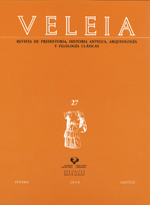Haches, diptongos y otros detalles de alguna importancia: notas sobre numerales (proto)vascos y comparación vasco-ibérica (con un apéndice sobre 'hiri' y otro sobre 'bat-bi')
##plugins.themes.bootstrap3.article.main##
##plugins.themes.bootstrap3.article.sidebar##
Abstract
This article analyses the theories about Basque-Iberian numerals proposed by Orduña (2005) and Ferrer i Jané (2009) from the point of view of Basque historical grammar. Besides the fact that there is no Basque-Iberian correspondence nor a reconstruction of the Basque-Iberian protolanguage, the supposed similarities that have been presented do not follow the evolutionary laws of Basque sounds (principally aspiration and diphthongs) nor its chronology. The hypothesis of the borrowing have already turned out implausible due to the limited (and remote) extension of the territory where Iberian was spoken as first language (cf. de Hoz 2009) and to the non-existence of Latin-Romance borrowings inferior to mila '1000'; moreover, we can now observe that most of the numerals offer satisfactory intra-Basque lexical and morphological explanations, which would be impossible were they really borrowings.
The first appendix analyses the word hiri 'city', probably the most famous supposed Iberian borrowing, and shows the weakness of the fundaments of this hypothesis as well as the possibility of explaining it through internal reconstruction (together with -(h)iri 'near, close', usually neglected). The second appendix presents a series of notes about the origins of bat '1' and bi '2', which are necessarily more speculative than those relating to the rest of numerals.
We think that this work shows once again the implausibleness of the Basque-Iberian hypotheses, either as a genetic relationship between both languages or as borrowings due to a significant and verifiable linguistic contact between them.
##plugins.themes.bootstrap3.article.details##
A no ser que se indique lo contrario, los contenidos de la edición electrónica de la plataforma OJS se regulan por una licencia de uso y distribución Creative Commons Reconocimiento 4.0 Internacional (CC BY 4.0).
La revista no cobra ninguna compensación económica a los autores por publicar en ella y da total acceso a los archivos sin ningún tipo de embargo desde el día de su publicación electrónica. Se respeta así la política nacional de acceso abierto.
Aquellos autores/as que tengan publicaciones con esta revista, aceptan los términos siguientes:
- Los autores/as conservarán sus derechos de autor y garantizarán a la revista el derecho de primera publicación de su obra, el cuál estará simultáneamente sujeto a la Licencia de reconocimiento de Creative Commons que permite a terceros compartir la obra siempre que se indique su autor y su primera publicación esta revista.
- Los autores/as podrán adoptar otros acuerdos de licencia no exclusiva de distribución de la versión de la obra publicada (p. ej.: depositarla en un archivo telemático institucional o publicarla en un volumen monográfico) siempre que se indique la publicación inicial en esta revista.
- Se permite y recomienda a los autores/as difundir su obra a través de Internet (p. ej.: en archivos telemáticos institucionales o en su página web) antes y durante el proceso de envío, lo cual puede producir intercambios interesantes y aumentar las citas de la obra publicada.

